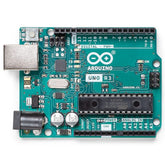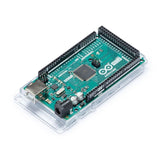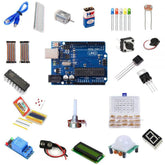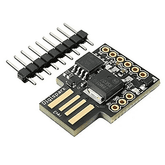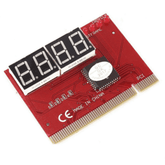What is Arduino UNO
Summary
Do you want to discover the Power of Innovation with Arduino Uno? in this blog Learn about this powerful microcontroller board in this blog its features, pin diagram, hardware components, and how to use it. With its versatile applications, the Arduino Uno has revolutionized the world of DIY electronics. Get ready to unleash your creativity and bring your projects to life with this amazing tool.
What is Arduino UNO?
Arduino Uno is an incredible tool for hobbyists, makers, and creatives looking to explore the world of physical computing.
Featuring an Atmega328 microcontroller with 14 digital input/output pins (of which 6 can be used as PWM outputs), 6 analog inputs, a 16 MHz crystal oscillator frequency clock speed and USB connection capability – it’s all you need to get creative ideas up and running in no time!
With its easy-to-use platform incorporating user friendly programming language loaded libraries; creating complex yet versatile projects has never been easier or more approachable.
Along with its accompanying software that provides instant feedback on coding errors - Arduino makes exploring interactive electronics fun again! Get started today by making amazing inventions come alive with Arduino Uno.
Shop the Arduino UNO R4 WiFi for versatile wireless control.
Arduino in Brief
Arduino is a popular open source platform that provides the tools to create interactive electronic projects. With its Simple and well-defined hardware, integrated development environment (IDE) and easy programming language makes it perfect for beginners as well as experienced makers.
Arduino offers an extensive range of components, from basic boards to advanced shields to third-party addons such as sensors, motors and actuators which make building IoT devices easier than ever before!
It also supports multiple languages such has C++ & Python making coding tasks simpler compared with other platforms available in the market today.
Arduino's flexibility allows users from all skill levels — whether absolute beginner or seasoned maker –to easily build creative DIY products quickly yet thoroughly without any hassle!
read more : Arduino Uno Pin Diagram: A Complete Guide
Arduino Uno - What is it?
The Arduino Uno is the latest edition of one of today's most popular prototyping platforms. An easy to use, all-in-one system that allows novice and advanced users alike to create digital designs quickly with minimal investment in time or resources; it has become an indispensable tool for makers around the world.
With its robust capabilities, intuitive interface, and comprehensive set of components – including sensors, motor controllers & shields – your projects will be up and running faster than ever before!
Whether you're looking for a basic platform or something more elaborate - Arduino delivers reliable performance every step of the way.

Fig.1. Arduino UNO board
The Arduino Uno is an open-source microcontroller board created by arduino.cc and was first made available in 2010. The board is furnished with sets of digital and analog input/output (I/O) pins that may be interfaced with various expansion boards (shields) and other circuits.
The board has 14 digital I/O pins, six of which are capable of PWM output, and six analog I/O pins. It resembles the Arduino Nano and Leonardo in certain ways.
It accepts voltages between 7 and 20 volts, but it can also be powered by an external 9-volt battery or by a USB cable.
The hardware reference design is made accessible on the Arduino website and is given under a Creative Commons Attribution Share-Alike 2.5 license. There are additional layout and production files available for various hardware versions.
read more : What is Arduino Nano
Arduino Uno Description:
Arduino Uno is an amazing open-source electronics platform designed to be used with a variety of projects.
It comes with all the necessary components, tools and codes needed for assembling electronic circuits so you can get started quickly and easily!
This kit includes everything from motor control boards to sensors, making it easy for users who want to dive into creating interactive objects or environments. Its design enables access to powerful external hardware while still offering low cost solutions that are simple enough even someone new in this field could use them without any problem.
Arduino Uno also makes updating your code easier than ever before – what more can you ask for?!
Arduino Uno Features
Equipped with all the essential features to seamlessly drive the controller, this board offers a direct USB connection to your computer.
Utilizing a USB cable, you can effortlessly transfer code to the controller through the Integrated Development Environment (IDE) software – a dedicated tool primarily tailored for Arduino programming. Now, let's delve into the realm of Arduino Uno's remarkable features.
- Amplified Frequency and Enhanced Instruction Throughput: The board houses the Atmega328 microcontroller, a powerhouse boasting an array of attributes such as timers, counters, interrupts, PWM, CPU, and an array of I/O pins. Operating on a 16MHz clock, this microcontroller effortlessly generates heightened frequency and a greater number of instructions per cycle.
- Integrated Voltage Regulation: The board features a built-in regulation mechanism that expertly maintains voltage stability when interfacing with external devices.
- Flexibility and User-Friendly Design: Incorporated within the board are 14 I/O digital pins and 6 analog pins, offering seamless external connections with various circuits. These pins empower external devices with flexibility and ease of integration.
- Adaptable Pin Configuration: The 6 analog pins, identified as A0 to A5, offer a resolution of 10 bits. Their voltage measurement spans from 0 to 5V, yet they can be reconfigured to accommodate a higher range through the analogReference() function and AREF pin.
- Effortless Initiation: A reset pin resides on the board, enabling a complete reset of the system, reverting the running program to its initial stage. This feature proves invaluable should the board encounter a freeze during program execution; a simple press of this pin eradicates glitches and initiates the program anew.
- Ample Flash Memory: With a capacious 13KB of flash memory, the board efficiently stores an abundance of instructions in code format.
- Minimal Voltage Demand: A mere 5V is all that's required to power up the board. This voltage can be conveniently supplied via a USB port or an external adapter. Moreover, the board can handle external power sources up to 12V, which can be skillfully regulated and limited to 5V or 3.3V, depending on the project's specifications.
- Effortless Connectivity: No convoluted interfaces are necessary to establish connections with external devices. Just insert the external device's pins into the neatly arranged header pins on the board.
- Seamless USB Interface: Arduino Uno is furnished with a user-friendly USB interface, facilitating smooth serial communication between the board and your computer.
- Diverse Power Options: Beyond USB connectivity, the board can also be powered through batteries or an AC to DC adapter.
- Expanded Storage Capability: The provision of a Micro SD card slot empowers the board to effortlessly accommodate a wealth of additional information.
read more : Arduino Pin Configuration
Arduino Uno Specifications
| Microcontroller | ATmega38P – 8 bit AVR family microcontroller |
| Operating Voltage | 5V |
| Recommended Input Voltage | 7-12V |
| Input Voltage Limits | 6-20V |
| Analog Input Pins | 6 (A0-A5) |
| Digital I/O Pins | 14 (Out of which 6 provide PWM output) |
| DC Current on I/O Pins | 40mA |
| DC Current on 3.3V Pin | 50mA |
| Flash Memory | 32 KB (0.5 KB is used for Bootloader) |
| SRAM | 2kB |
| EEPROM | 1kB |
| Frequency (Clock Speed) | 16MHz |
read our blog explaining the microcontroller used in arduino uno, provides detailed information about the microcontroller used in Arduino UNO, specifically focusing on the ATmega328P.
Arduino UNO Pin Diagram

Fig.2. Arduino UNO pin diagram
| Pin Category | Pin Name | Details |
| Power | Vin, 3.3V, 5V, GND | Vin: Input voltage to Arduino when using an external power source. 5V: Regulated power supply used to power microcontroller and other components on the board. 3.3V: 3.3V supply generated by on-board voltage regulator. Maximum current draw is 50mA. GND: ground pins. |
| Reset | Reset | Resets the microcontroller. |
| Analog Pins | A0-A5 | Used to provide analog input in the range of 0-5V |
| Input/Output Pins | Input/Output Pins | Can be used as input or output pins. |
| Serial | 0(Rx), 1(Tx) | Used to receive and transmit TTL serial data. |
| External Interrupts | 2, 3 | To trigger an interrupt. |
| PWM | 3, 5, 6, 9, 11 | Provides 8-bit PWM output. |
| SPI | 10 (SS), 11 (MOSI), 12 (MISO) and 13 (SCK) | Used for SPI communication. |
| Inbuilt LED | 13 | To turn on the inbuilt LED. |
| TWI | A4 (SDA), A5 (SCA) | Used for TWI communication. |
| AREF | Analogue REFerence | To provide reference voltage for input voltage. |
Arduino uno Pin Description
Within the realm of Arduino Uno lies a collection of pins, encompassing I/O digital and analog pins, all meticulously placed on the board operating at 5V.
These pins exhibit standardized operational ratings spanning from 20mA to 40mA. Ingeniously integrated internal pull-up resistors serve as sentinels, capping the current flow within the prescribed operational thresholds.
Nevertheless, a surge in current beyond these limits renders these resistors ineffective, potentially leading to device impairment.
- LED: Arduino Uno boasts an embedded LED seamlessly tethered to pin 13. Emitting a HIGH value to the pin activates the LED, while a LOW value deactivates it.
- Vin: Serving as the lifeblood of the Arduino Board, Vin functions as the input voltage port. It serves as a conduit for voltage supply, distinct from the 5V furnished through the USB port. When voltage is provided via the power jack, this pin offers access to that power source.
- 5V: Emanating the prowess of voltage regulation, the 5V pin bestows regulated output voltage. The board garners power through three avenues: USB, the Vin pin, or the DC power jack. USB furnishes approximately 5V, whereas Vin and the Power Jack extend their support to a voltage range spanning 7V to 20V.
- GND: Ground pins, multiple in number, act as the foundation of connectivity. Their deployment is adaptable, aligned with distinct requirements.
- Reset: This pivotal pin rests at the heart of the board, enabling the reset of running programs. While physical resets were the norm, the IDE introduces a novel programming-driven reset feature.
- IOREF: The acronym denoting Input Output Voltage Reference, IOREF assumes a crucial role in furnishing voltage reference to the board. A specialized shield interprets the voltage across this pin, subsequently selecting the appropriate power source.
- PWM: Pulse Width Modulation emanates from pins 3, 5, 6, 9, 10, and 11, rendering 8-bit output PWM configurations attainable.
- SPI: Serial Peripheral Interface, succinctly SPI, leverages pins 10 (SS), 11 (MOSI), 12 (MISO), and 13 (SCK), facilitated through the SPI library, for seamless SPI communication.
- AREF: Analog Reference, encapsulated in AREF, is the conduit for channeling reference voltage to analog inputs.
- TWI: The Two-Wire Interface, abbreviated as TWI, interfaces through the Wire Library, with A4 and A5 executing this communication role.
- Serial Communication: The baton of serial communication is passed through Pins 0 (Rx) and 1 (Tx).
- Rx and Tx: Functioning as Receiver and Transmitter, Rx and Tx pins facilitate data reception and transmission, respectively.
- External Interrupts: The role of Pins 2 and 3 is dedicated to external interrupts. Triggered by LOW signals or value changes, these interrupts serve as pivotal event markers.
Arduino Uno unveils its prowess through seamless interaction with fellow Arduino boards, microcontrollers, and computers. The Atmega328 microcontroller, nestled within, orchestrates serial communication via pins such as Rx and Tx.
Enter the Atmega16U2, an integral player facilitating serial communication via USB COM drivers. A Serial Monitor on the IDE software serves as the conduit for exchanging text data with the board.
The communication's pulse is symbolized by LEDs on the Rx and Tx pins, flashing in tandem with data transmission. To grasp the intricacies, one must delve into the programming tapestry of Arduino's realm.
read more : Which Arduino Board to Buy
Arduino Uno - Getting into Programming
With the Arduino Uno, a world of possibilities unfolds through its 14 digital input/output pins, ready to serve as input or output channels via the pinMode(), digitalRead(), and digitalWrite() functions in Arduino programming.
Each pin operates at a robust 5V, capable of delivering or receiving up to 40mA of current. Moreover, these pins are graced with an internal pull-up resistor, spanning the range of 20-50 KOhms, though initially left disconnected. Among these 14 pins, a subset assumes distinct roles:
Arduino Uno Pin Overview:
- Serial Pins 0 (Rx) and 1 (Tx): These pivotal pins, Rx and Tx, stand poised to receive and transmit TTL serial data. They forge a connection with the ATmega328P USB to TTL serial chip, orchestrating seamless communication.
- External Interrupt Pins 2 and 3: These versatile pins can be deftly configured to trigger an interrupt on various conditions – a low value, a rising or falling edge, or even a change in value.
- PWM Pins 3, 5, 6, 9, and 11: These dynamic pins exhibit their prowess by facilitating 8-bit PWM outputs via the analogWrite() function, empowering nuanced control.
- SPI Pins 10 (SS), 11 (MOSI), 12 (MISO), and 13 (SCK): These well-coordinated pins are dedicated to the art of SPI communication, facilitating seamless data exchange.
- Built-in LED Pin 13: This pin shares a symbiotic connection with a built-in LED. When elevated to HIGH, the LED shines brilliantly, and when reduced to LOW, it gracefully dims.
Amidst these 14 Digital pins, an assembly of 6 analog input pins thrives, each capable of rendering 10 bits of resolution, translating to 1024 distinctive values.
Operating within a 0 to 5-volt range, this boundary can be expanded via the AREF pin and the analogReference() function.
Additionally, Analog pin 4 (SDA) and pin 5 (SCL) join forces to support TWI communication through the Wire library.
- AREF: A beacon of reference voltage for analog inputs, diligently guided by the analogReference() function.
- Reset Pin: Its humble yet profound role involves resetting the microcontroller, achieved by grounding this pin.
Data Transmission with Arduino:
- Arduino takes the helm in communication with computers, fellow Arduino boards, and a myriad of microcontrollers. The ATmega328P microcontroller stands as a sentinel, offering UART TTL (5V) serial communication.
- For this dialogue, digital pin 0 (Rx) and digital pin 1 (Tx) come into play, channeling serial communication. An ATmega16U2 on the board elevates this interaction to the virtual realm via USB, presenting itself as a virtual com port to computer software.
- The firmware of ATmega16U2 harmonizes with standard USB COM drivers, nullifying the need for external drivers. However, on Windows, a .inf file emerges as a prerequisite.
- Armed with a serial monitor, the Arduino software introduces a portal for uncomplicated textual data exchange between the board and the computer.
- Two illuminating LEDs – RX and TX – embrace the role of indicators, flickering as data courses through the USB-to-serial chip and its connection to the computer. It's important to note that this spectacle doesn't apply to serial communication on pins 0 and 1.
- Expanding the Spectrum: Arduino's Versatile Serial Abilities:
- Through the SoftwareSerial library, a broad spectrum of digital pins on the Uno is primed for serial communication.
- Yet, the ATmega328P boasts even more potential, embracing I2C (TWI) and SPI communication. The Wire library, integral to the Arduino software, ushers in simplicity in wielding the I2C bus's capabilities.
read more : Interfacing Proximity Sensors with Arduino
Hardware Components:

Fig.3. Components present in the Arduino UNO board
- Microcontroller ATmega328: This member of the Atmel family is a single-chip microcontroller. Its processor code is 8 bits in size. In addition to Memory (SRAM, EEPROM, and Flash), Analog to Digital Converter, SPI serial ports, I/O lines, registers, timer, external and internal interrupts, and oscillator, it also includes an oscillator.
- The In-Circuit Serial Programming (ICSP) pin enables programming with the Arduino board's firmware.
- Power LED Indicator: An ON LED indicates that power is on. The LED won't light up if the power is turned off.
- Digital I/O pins: Digital pins can be HIGH or LOW in value. Digital pins are those with the numbers D0 through D13.
- TX and RX LEDs signify a successful data transfer.
- The Arduino UNO board receives a reference voltage from the external power source via the Analog Reference (AREF) pin.
- Reset button: It is used to give the connection a Reset button.
- The board can connect to the computer through USB. It is necessary for the Arduino UNO board's programming.
- Crystal Oscillator: The Arduino UNO is a robust board due to the 16MHz crystal oscillator.
- Using a voltage regulator, the input voltage is changed to 5V.
- GND — Ground pins The ground pin functions as a pin that is not powered.
How to use the Arduino UNO
As we mentioned, it works by using the software. Generally, all are preferred the Arduino Integrated Development Environment software, The screenshot of the software were pasted below,
Fig.4. Arduino IDE
Basically, it consists of two sections called void functions, first section is the void setup() function you will initialize the pin and other things that you want and it runs only once. Secondly, the void loop() function that you can run your code multiple times.

Fig.5. Verify button in Arduino IDE
After the code is written you can verify your code by clicking the verify button shown in fig. 5

Fig.6. Select the board in Arduino UNO

Fig.7. Select the Port in Arduino UNO
Once the code is verified, select the board and port shown in the above fig 6 and fig 7 respectively. After that upload the code to your Arduino UNO Board.
How to Connect Arduino to PC?
Connecting an Arduino to your PC is a straightforward process that has many applications in home automation, robotics and more. To begin, access the device manager on your computer or laptop.
Then ensure you have installed all necessary drivers—especially those associated with USB serial ports—which will allow communication between hardware components such as the Arduino board and microcontroller boards.
Once this set up stage is complete, plug in the cable from your PC to whichever version of board (Uno/Mega) you are using for programming into one of its respective USB ports located at either side edge of it's surface area.
Now open Arudino’s own bundled IDE software which can be used for coding projects based off C++ language specifications; allowing them to compile quickly onto connected devices like arduinos etc., making sure however any wiring connections made earlier have been bridged securely!
Finally after code written by user has transferred over successfully click ‘Upload’ button found within program window - resulting project should now execute itself thereby completing connection setup & operation cycle!
Applications of Arduino UNO:
The Arduino boards can be used for standalone projects as well as for interfacing with different sensors and actuators. The following uses use the Arduino UNO board.
- Weighing Machines
- Traffic Light Count Down Timer
- Parking Lot Counter
- Embedded systems
- Home Automation
- Industrial Automation
- Medical Instrument
- Emergency Light for Railways
read more : Top 10 Arduino Projects to Get Started With
Conclusion
In this blog post, we have learnt that The Arduino Uno, a microcontroller board of immense capability and versatility, has unleashed a veritable whirlwind of innovation in the realm of DIY electronics and robotics!
Its user-friendly attributes, hardware components and software libraries make it a darling of makers, hobbyists, and professional engineers alike.
If you appreciate our work don't forget to share this post and leave your opinion in the comment box.
Please do check out other blog posts about Popular electronics
Make sure you check out our wide range of products and collections (we offer some exciting deals!)



